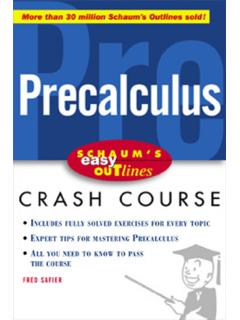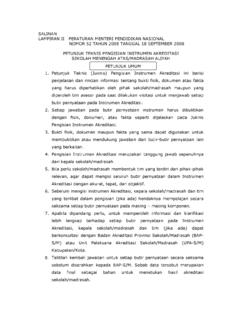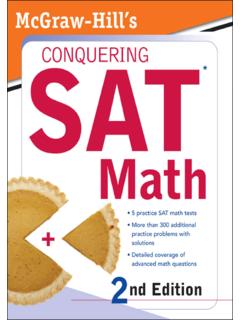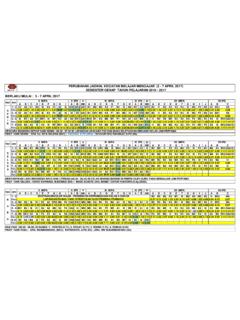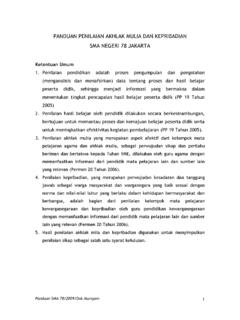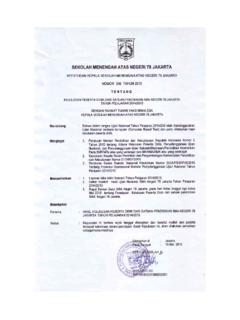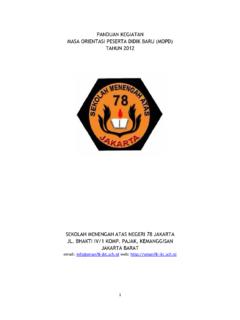Transcription of SCHAUM’S OUTLZNE OF - sman78-jkt.sch.id
1 I .-w schaum S OUTLZNE OF THEORY AND PROBLEMS OF BASIC ELECTRICITY MILTON GUSSOW, Senior Engineer Applied Physics Laboratory The Johns Hopkins University McGraw-Hill New York San Francisco Washington, Auckland Bogota Caracas Lisbon London Madrid Mexico City Milan Montreal New Delhi San Juan Singapore Sydney Tokyo Toronto To Libbie, Myra, and Susan MILTON GUSSOW is a senior engineer at Johns Hopkins University Applied Physics Laboratory. He received his (1949) from the Naval Academy, his (1956) from the Navy Postgraduate School, and his (1957) from Massachusetts Institute of Technology. He is an Adjunct Professor at American University and George Washington University where he teaches courses in mathematics and elkctrical engineering. Mr. Gussow was formerly Senior Vice President for Education at the McGraw-Hill Continuing Education Center.
2 He is the author of over fifty technical papers. schaum s Outline of Theory and Problems of BASIC ELECTRICITY Copyright 0 1983 by The McGraw-Hill Companies, Inc. All rights reserved. Printed in the United States of America. Except as permitted under the Copyright Act of 1976, no part of this publication may be reproduced or distributed in any form or by any means, or stored in a data base or retrieval system, without the prior written permission of the publisher. 16 17 18 19 20 BAW 9 9 ISBN 0-03-025240-8 Sponsoring Editor, John Aliano Consulting Editor, Gordon Rockmaker Editing Supervisor, Marthe Grice Production Manager, Nick Monti Library of Congress Catalogjng in Publication Data Gussow, Milton. electricity. schaum s outline of theory and problems of basic ( schaum s outline series) Includes index. 1. Electricity. I. Title. 1983 62 02 02 82-467 1 ISBN 0-07-025240-8 E McGraw -Hill A Division of 7-k Mc# Companies Preface This book is intended as a basic text to cover the fundamentals of electricity and electric circuits.
3 It may be used by beginning students in high schools, technical institutes, and colleges who have no experience in electricity. Explanations and step-by-step solutions are deliberately detailed so that the text can stand alone. Thus it also may be used as a home-study or reference book. A knowledge of basic algebra and trigonometry is assumed. Designed to provide a broad and deep background in the nature of electricity and the opera- tion and application of electric circuits, the text uses numerous and easy-to- follow examples accompanied by diagrams. Starting with the physics of electric current flow, the book describes and analyzes both direct-current and alterna- ting-current electric circuits, generators and motors, transformers, and measuring instruments. To assure correlation to modern practice and design, illustrative problems are presented in terms of commonly used voltages and current ratings, covering circuits and equipments typical of those found in today s electrical systems.
4 There are several special features of this book. One is the use of the International System of Units (SI) throughout. A second is the prolific use of equation numbers for reference so that the reader will always know the source of each equation used. Other features include simplified ways to solve problems on three-phase transformer windings, series and parallel resonance, and RL and RC circuit waveforms. I wish to thank John Aliano, Gordon Rockmaker, and Marthe Grice of the McGraw-Hill Book Company for their many constructive criticisms and con- tinuing efforts to get this book published. MILTON Gussow This page intentionally left blank CONTENTS Chapter 20 ELECTRICAL MEASUREMENTS .. 411 Basic Measuring Instruments .. 411 Ammeters .. 411 Voltmeters .. 414 Ohmmeters .. 416 Multimeters .. 419 Alternating-Current Meters .. 419 Wattmeters and Watthour Meters .. Analog Electronic Meters.
5 427 Digital Meters .. 429 425 INDEX .. 447 Contents Chapter 1 THE NATURE OF ELECTRICITY .. Structure of the Atom .. The Electric Charge .. The Coulomb .. The Electrostatic Field .. Potential Difference .. Current .. Current Flow .. Sources of Electricity .. Direct and Alternating Currents and Voltages .. 1 1 3 4 4 5 5 6 7 8 Chapter 2 ELECTRICAL STANDARDS AND CONVENTIONS .. 15 Units Introduction .. Metric Prefixes .. Powers of 10 .. Scientific Notation .. Rounding Off Numbers .. Graphical Symbols and Electrical Diagrams Schematic Diagram .. One-Line Diagram .. Block Diagram .. Wiring Diagram .. Electric Plan .. 15 15 16 20 20 27 28 31 31 31 Chapter 3 OHM S LAW AND POWER .. 38 .. The Electric Circuit 38 Resistance .. 39 Fixed Resistors .. 39 Variable Resistors .. 40 Ohm s Law 41 Electric Power .. 42 Horsepower .. 43 Electrical Energy .. 44 .. Chapter 4 DIRECT-CURRENT SERIES CIRCUITS.
6 50 Voltage. Current. and Resistance in Series Circuits .. 50 Polarity of Voltage Drops .. 53 Conductors .. 53 Total Power in a Series Circuit .. 57 Voltage Drop by Proportional Parts .. 58 CONTENTS Chapter 5 DIRECT-CURRENT PARALLEL CIRCUITS .. 69 Voltage and Current in a Parallel Circuit .. 69 Resistances in Parallel .. 71 Open and Short Circuits .. 74 Division of Current in Two Parallel Branches .. 75 Conductances in Parallel .. 75 Power in Parallel Circuits .. 77 Chapter 6 BATTERIES .. 88 The Voltaic Cell .. 88 89 Series and Parallel Cells .. Primary and Secondary Cells .. 90 Types of Batteries .. 90 94 Battery Characteristics .. Chapter 7 KIRCHHOFF S LAWS .. 101 Kirchhoff s Voltage Law (KVL) .. 101 Kirchhoff s Current Law (KCL) .. 103 Mesh Currents .. 104 Node Voltages .. 106 Chapter 8 NETWORK CALCULATIONS .. 116 Y and Delta Networks .. 116 Superposition .. 120 Thevenin s Theorem.
7 122 Norton s Theorem .. 124 Series-Parallel Circuits .. 126 Wheatstone Bridge Circuit .. 128 Maximum Power Transfer .. 129 Line-Drop Calculations .. 130 Three-Wire Distribution Systems .. 131 Chapter 9 MAGNETISM AND ELECTROMAGNETISM .. 162 The Nature of Magnetism .. Magnetic Materials .. 163 Electromagnetism .. 164 Magnetic Units .. 167 BH Magnetization Curve .. 168 Magnetic Circuits .. 170 Electromagnetic Induction .. 172 International System of Units .. 162 174 CONTENTS Chapter 10 DIRECT-CURRENT GENERATORS AND MOTORS .. 184 Motors and Generators .. 184 Simple DC Generator .. 185 Armature Windings .. 186 Field Excitation .. 187 DC Generator Equivalent Circuit .. 188 Generator Voltage Equations and Voltage Regulation .. 189 Losses and Efficiency of a DC Machine .. 189 Direct-Current Motor .. 191 DC Motor Equivalent Circuit .. 192 Speed of a Motor .. 193 Motor Types .. 194 Starting Requirements for Motors.
8 1% Chapter 11 PRINCIPLES OF ALTERNATING CURRENT .. 205 Generating an Alternating Voltage .. 205 Angular Measurement .. 205 Sine Wave .. 206 Alternating Current .. 207 Frequency and Period .. 208 Phase Relationships .. 209 Phasors .. 209 Characteristic Values of Voltage and Current .. 211 Resistance in AC Circuits .. 213 Chapter 12 INDUCTANCE. INDUCTIVE REACTANCE. AND INDUCTIVE CIRCUITS .. 225 Induction .. 225 Characteristics of Coils .. 226 Inductive Reactance .. 227 Inductors in Series or Parallel .. 228 Inductive Circuits .. 231 Q of a Coil .. 237 Power in RL Circuits .. 237 Chapter 13 CAPACITANCE. CAPACITIVE REACTANCE. AND CAPACITIVE CIRCUITS .. Capacitor .. Capacitance .. Types of Capacitors .. Capacitors in Series and Parallel .. Capacitive Reactance .. Capacitive Circuits .. Power in RC Circuits .. 251 251 252 254 254 256 257 262 CONTENTS Chapter 14 SINGLE-PHASE CIRCUITS.
9 275 The General RLC Circuit .. 275 RLC in Series .. 275 RLC in Parallel .. 278 RL and RC Branches in Parallel .. 280 Power and Power Factor .. 282 Chapter 15 ALTERNATING-CURRENT GENERATORS AND MOTORS .. 300 Paralleling Generators .. 302 Ratings .. 303 Losses and Efficiency .. 303 Polyphase Induction Motors .. 303 Synchronous Motors .. 306 Single-Phase Motors .. 310 Alternators .. 300 Chapter 1 6 TRANSFORMERS .. 322 Ideal Transformer Characteristics .. 322 Transformer Ratings .. 325 Impedance Ratio .. 326 Transformer Losses and Efficiency .. Coil Polarity .. 329 Autotransformer .. 326 327 No-Load Condition .. 328 Chapter 17 THREE-PHASE SYSTEMS .. 339 Characteristics of Three-Phase Systems .. 339 Three-Phase Transformer Connections .. 340 Power in Balanced Three-Phase Loads .. 342 Unbalanced Three-Phase Loads .. 346 Chapter 16 SERIES AND PARALLEL RESONANCE .. 362 Series Resonance.
10 362 Q of Series Circuit .. 365 Parallel Resonance .. 366 Q of Parallel Circuit .. 369 Bandwidth and Power of Resonant Circuit .. 370 Chapter 19 WAVEFORMS AND TIME CONSTANTS .. 384 RL Series Circuit Waveforms .. 384 RL Time Constants .. 388 RC Series Circuit Waveforms .. 390 RC Time Constants .. 393 Calculation for Time r .. 394 This page intentionally left blank Chapter 1 The Nature of Electricity STRUCTURE OF THE ATOM Matter is anything that has mass and occupies space. Matter is composed of very small particles called atoms. All matter can be classified into either one of two groups: elements or compounds. In an element, all the atoms are the same. Examples of elements are aluminum, copper, carbon, germanium, and silicon. A compound is a combination of elements. Water, for example, is a compound consisting of the elements hydrogen and oxygen. The smallest particle of any compound that retains the original characteristics of that compound is called a molecule.
